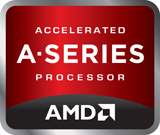Related Research Articles

Advanced Micro Devices, Inc. (AMD) is an American multinational semiconductor company based in Santa Clara, California, that develops computer processors and related technologies for business and consumer markets. While it initially manufactured its own processors, the company later outsourced its manufacturing, a practice known as going fabless, after GlobalFoundries was spun off in 2009. AMD's main products include microprocessors, motherboard chipsets, embedded processors and graphics processors for servers, workstations, personal computers and embedded system applications.
The x86 instruction set refers to the set of instructions that x86-compatible microprocessors support. The instructions are usually part of an executable program, often stored as a computer file and executed on the processor.
The AMD Family 10h, or K10, is a microprocessor microarchitecture by AMD based on the K8 microarchitecture. Though there were once reports that the K10 had been canceled, the first third-generation Opteron products for servers were launched on September 10, 2007, with the Phenom processors for desktops following and launching on November 11, 2007 as the immediate successors to the K8 series of processors.
Supplemental Streaming SIMD Extensions 3 is a SIMD instruction set created by Intel and is the fourth iteration of the SSE technology.
SSE4 is a SIMD CPU instruction set used in the Intel Core microarchitecture and AMD K10 (K8L). It was announced on September 27, 2006, at the Fall 2006 Intel Developer Forum, with vague details in a white paper; more precise details of 47 instructions became available at the Spring 2007 Intel Developer Forum in Beijing, in the presentation. SSE4 is fully compatible with software written for previous generations of Intel 64 and IA-32 architecture microprocessors. All existing software continues to run correctly without modification on microprocessors that incorporate SSE4, as well as in the presence of existing and new applications that incorporate SSE4.

Nehalem is the codename for Intel's 45 nm microarchitecture released in November 2008. It was used in the first-generation of the Intel Core i5 and i7 processors, and succeeds the older Core microarchitecture used on Core 2 processors. The term "Nehalem" comes from the Nehalem River.

The AMD Accelerated Processing Unit (APU), formerly known as Fusion, is the marketing term for a series of 64-bit microprocessors from Advanced Micro Devices (AMD), designed to act as a central processing unit (CPU) and graphics processing unit (GPU) on a single die. APUs are general purpose processors that feature integrated graphics processors (IGPs).
The AMD Bobcat Family 14h is a microarchitecture created by AMD for its AMD APUs, aimed at a low-power/low-cost market.
The AMD Bulldozer Family 15h is a microprocessor microarchitecture for the FX and Opteron line of processors, developed by AMD for the desktop and server markets. Bulldozer is the codename for this family of microarchitectures. It was released on October 12, 2011, as the successor to the K10 microarchitecture.

Graphics Core Next (GCN) is the codename for both a series of microarchitectures as well as for an instruction set architecture that was developed by AMD for their GPUs as the successor to their TeraScale microarchitecture/instruction set. The first product featuring GCN was launched on January 9, 2012.
The AMD Jaguar Family 16h is a low-power microarchitecture designed by AMD. It is used in APUs succeeding the Bobcat Family microarchitecture in 2013 and being succeeded by AMD's Puma architecture in 2014. It is two-way superscalar and capable of out-of-order execution. It is used in AMD's Semi-Custom Business Unit as a design for custom processors and is used by AMD in four product families: Kabini aimed at notebooks and mini PCs, Temash aimed at tablets, Kyoto aimed at micro-servers, and the G-Series aimed at embedded applications. Both the PlayStation 4 and the Xbox One use chips based on the Jaguar microarchitecture, with more powerful GPUs than AMD sells in its own commercially available Jaguar APUs.
AMD Steamroller Family 15h is a microarchitecture developed by AMD for AMD APUs, which succeeded Piledriver in the beginning of 2014 as the third-generation Bulldozer-based microarchitecture. Steamroller APUs continue to use two-core modules as their predecessors, while aiming at achieving greater levels of parallelism.
Video Code Engine is AMD's video encoding ASIC implementing the video codec H.264/MPEG-4 AVC. Since 2012 it is integrated into all of their GPUs and APUs except Oland.
AMD's Socket FT3 or BGA-769 targets mobile devices and was designed for APUs codenamed Kabini and Temash, Beema and Mullins.

Zen is the codename for the first iteration in a family of computer processor microarchitectures of the same name from AMD. It was first used with their Ryzen series of CPUs in February 2017. The first Zen-based preview system was demonstrated at E3 2016, and first substantially detailed at an event hosted a block away from the Intel Developer Forum 2016. The first Zen-based CPUs codenamed "Summit Ridge" reached the market in early March 2017, Zen-derived Epyc server processors launched in June 2017 and Zen-based APUs arrived in November 2017.
Ryzen is a brand of x86-64 microprocessors designed and marketed by Advanced Micro Devices (AMD) for desktop, mobile, server, and embedded platforms based on the Zen microarchitecture. It consists of central processing units (CPUs) marketed for mainstream, enthusiast, server, and workstation segments and accelerated processing units (APUs) marketed for mainstream and entry-level segments and embedded systems applications.
References
- 1 2 "Software Optimization Guide for Family 16h Processors". AMD. Retrieved August 3, 2013.
- ↑ "AMD launches new Beema, Mullins SoCs". ExtremeTech . 2014-04-29. Retrieved 2014-05-02.
- ↑ Shimpi, Anand. "AMD Beema/Mullins Architecture & Performance Preview". AnandTech. Retrieved 29 April 2014.
- ↑ Shimpi, Anand. "New Turbo Boost, The Lineup and Trustzone". AnandTech. Retrieved 29 April 2014.
- ↑ Woligroski, Don. "Meet The Mullins And Beema Tablet APUs". Toms Hardware. Retrieved 29 April 2014.